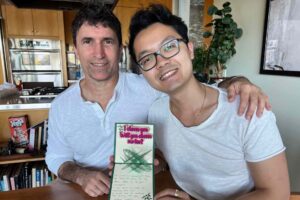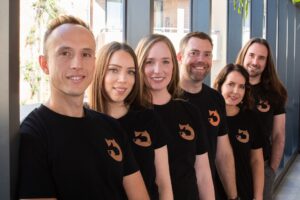“But gay couples can’t just have a child suddenly, right?
It takes years of laser precision and planning.
Everything must go right for us to have a child. So, while the idea had always been in our minds, we had absolutely no idea where to start”.
Tim, an actuary with Macquarie Bank and Sasha, a film producer and editor have been together in a loving relationship for 11 years. They always knew they wanted to be parents.
But it wasn’t until 2021, when Sasha gave Tim “the nudge”, saying “we’re both doing better in our careers and we are not getting any younger” that the two decided to make the jump from wanting to becoming parents.
“Coincidentally, I came across this rainbow family podcast on LinkedIn with financial adviser and former Macquarie Bank director, Glen Hare.
He talked about techniques like using multiple accounts to ‘bucket’ your expenses, building up your savings through passive investments and he talked about some of the challenges that LGBT people may face when starting a family.
I watched the whole video and one line in particular stuck out to me, that most couples don’t even know how much it’s going to cost to go through adoption or surrogacy, and I immediately thought to myself – ‘I think it’s time to get some help’”.
Tim reached out to Glen with three goals in mind; to shore up his family’s financial position ahead of trying for a baby, to get career advice from a former Macquarie executive and, of course, find out more about rainbow families.
“And I got all three!” Says Tim. “Glen put me in touch with Rainbow Families who, in turn, put me in touch with Surrogacy Australia and that’s where the journey really began.
I negotiated a period of three-month part-time, three-month unpaid leave from work; we put together the cashflow plan that would allow me to take this time off and then I started researching.
That was step one.”

Tim & Sasha had been together 11 years when Sasha ‘gave the nudge’. The pair transitioned quickly from wanting to becoming parents – and wanted to get their finances in order to reflect that change.
Altruistic or commercial surrogacy?
“For me and Sasha, the attitude was that we would leave no stone untouched or unturned. Surrogacy legislation is very complex, there’s a lot to consider and every choice you make has a different implication.
We discovered that we wanted to pursue domestic surrogacy, also called altruistic surrogacy, which means that you do not pay the surrogate to carry your child.”
Altruistic surrogacy, where the surrogate receives no financial compensation beyond reasonable expenses is the only legal form of surrogacy in Australia.
Commercial surrogacy, which involves payment to the surrogate beyond expenses is not permitted in Australia, but legal in many other jurisdictions, including the United States, Canada and Colombia, leading many couples to look internationally.
“So, after choosing the domestic option, we put in our profile with surrogacy Australia. It was only one page, but I spent so many days and nights sitting at my computer trying to get it right, trying to make it perfect, then Sasha would review, and it’d be back and forth all over again! “
Tim and Sasha submitted their profile in March 2022, expecting a minimum twelve month wait before hearing back.
Surrogacy is not common in Australia, according to family creation lawyer, Sarah Jefford OAM, approximately 120 surro-babies are born in Australia every year, while several hundred are born overseas. “While I support and encourage surrogacy within Australia, the reality is that only 1 in 5 couples seeking a surrogate will find one in at home” says Jefford.
“I thought we would have 12 months ahead of us to get prepared, travel and relax a bit” Says Tim “and then, just three months later, our surrogate came into our life and changed everything”.

Tim and Sasha’s journey to parenthood is a testament to the diverse pathways to creating a family. Fox & Hare recognise the unique needs of each individual and couple, providing tailored advice and support to ensure every family can achieve their goals. Click the image to claim a free 45 minute discovery session with our member success manager, Will.
From there, we met our surrogate.
Tim and Sasha met their surrogate Lizzy, a mother of three from NSW’s Blue Mountains, just three months after posting their profile with Surrogacy Australia – eight months ahead of schedule!
From there, the three embarked on a six-month ‘surro-dating’ journey “that’s the terminology for the period when you get to know your surrogate and she gets to know you” says Tim “this is the time to bring up and discuss all the questions about surrogacy, pregnancy and birth.”
Tim reports many tough but necessary conversations, covering topics like personal values, abortion and what to do if something goes wrong.
“Pretty much every topic had to be touched on and discussed”.
Over this period, the bond between the trio grew stronger and Tim confided in Lizzie that he would be proposing to Sasha on an upcoming trip to the US. “She gave me an envelope and said, ‘only open this after you’ve proposed to Sasha’.
So, that’s what I did. I trusted there was nothing fishy in the envelope that’d land me in hot water with US customs (talk about trust in altruistic surrogacy) and saved the envelope. When we got engaged, and when we opened the envelope, it read: ‘I’ve chosen the two of you, would you choose me?’
It was her offer to be our surrogate.”

From letter to little one, Tim and Sasha’s surrogacy journey was filled with hope and determination. They planned their finances carefully every step of the way. Click the image to claim a free 45 minute discovery call with our member success manager, Will. Find out how Fox & Hare can help power your family’s dreams.
Navigating legal, financial and medical complexities.
“Surrogacy legislation is very complex,” reflects Tim.
“There’s a lot you have to consider, every option that you take has a different implication and the process is very expensive.
You will be dealing with psychologists, and there will be lawyers, your IVF clinic and then you might need your own GP & OBGYN as well. So, that’s a lot of professionals you will be dealing with on your surrogacy journey.
I think that typically, based on Surrogacy Australia’s research, you’re looking at a cost between $50,000 and $100,000 over three years. It’s not like one lump sum and you’re done. You’ll be working with different professionals and services at different times throughout your journey.”
Sarah Jefford reports an even greater variance in the potential costs for families, from $15,000 to $100,000. “The major variable is the cost of fertility treatment, which will depend on what sort of treatment you require, the success of any treatment and when the surrogate falls pregnant” she says.
Adding to the cost and complexity was Tim and Sasha’s decision to pursue IVF treatment in the United States.
The choice stemmed from their connection with a doctor practicing in Los Angeles and the availability of their chosen egg donor in the USA. While this decision streamlined certain aspects of the process, and resulted in first attempt pregnancy, it also introduced logistical challenges and additional costs.
“Because our doctor and egg donor were both in the US, it was a lot easier for the three of us to fly to Los Angeles, do the embryo transfer over there and then come home.
It was a lot of extra cost, but we had planned for it. We started the journey with our budget and stuck to it. So, there were no big surprises in terms of finance for us.”

Tim and Sasha’s magical moment was years in the making, and included careful financial planning. Click the image to connect with Fox & Hare’s member success manager Will. He’ll determine if we can help you bring your dreams to life.
What it’s like to be pregnant.
“Two weeks after we came home from the United States, Lizzy came over to visit us with this big box. Inside was a homemade cake with “we did it” written in blue icing. So, that’s how we found out Lizzy was pregnant with a boy.” Tim remembers.
“For me, there were tears, but we also tried to contain our excitement. We knew that we’d need to get through the next at 12 weeks to know for sure we’re having a baby”
The first 20 weeks of pregnancy, particularly for those who have undergone IVF, are often fraught with a mix of excitement and anxiety. The risk of miscarriage is highest during this period and can heighten the fear associated with the early stages of pregnancy. The developing baby is also most vulnerable to potential complications and birth defects during the first trimester.
“It was a huge relief to know that all our hard work had paid off. It was an emotional roller coaster, for sure, and we were so happy. But we were also like ‘oh shit! We really, really need to get our house in order to welcome a newborn.”
After the twenty-week milestone; which is often considered a turning point in the pregnancy, followed by a lower risk of pregnancy loss and providing reassurances about the baby’s health and development, Tim and Sasha set about telling their friends and family.
“Seeing our friends and family so excited for us made me extra happy. I’m not sure who had the biggest reaction, but it’s between Sasha’s mum and our God children’s mum.
There were lots of tears, I think my mother-in-law called us after every ultrasound, and every time we mentioned Atticus she would cry. It was so heartwarming.”

Tim, Sasha, and Lizzie glowed in the final stages of pregnancy. They make it look easy but growing a family through surrogacy takes love, support… and a bit of planning! To find out how Fox & Hare can help you prepare for the costs associated with surrogacy (or any other goal), click the image to claim your free 45-minute consultation with our member success manager, Will.
The virtues of altruistic surrogacy
Lizzy, already a mother of two, sailed through the pregnancy with no problems and the two families grew closer as they progressed through the journey together.
“One of the virtues of altruistic surrogacy is getting to be involved throughout the whole journey. Not only did we get to see Atticus grow at every ultrasound, but we got to know Lizzie and her family too.
It was incredible.
We got so close, we got to know each other so well and we were just amazed at Lizzy and her community.
They are so family oriented; seeing how much love there is just further confirmed why she chose to be an altruistic surrogate.
Toward the end of the term, we did a pregnancy photoshoot where we all dressed up in Harry Potter costumes – because Harry Potter is Lizzy’s favourite novel – and Lizzy’s two children held up a sign saying ‘my mum is helping to create an amazing family. Atticus coming soon! February 2024’.
As you can imagine, we feel very blessed to have had this type of journey”

Celebrating new life and family bonds! Lizzie’s children welcome baby Atticus and celebrate their mum’s role in helping Tim & Sasha start a family of their own. Click the image to claim your free call with Fox & Hare’s member success manager, Will. Find out how we plan for starting and growing families.
It’s a boy!
The culmination of years of planning, hard work and anticipation finally arrived in February 2024.
Atticus was born – but with a worrying twist.
“So, because the pregnancy was so smooth, the birth itself caught us off guard.
We thought ‘the pregnancy is going so well, Lizzy’s already had two kids with a natural birth, this will be a water slide’ but that’s not how it turned out.
Atticus’ birth threw a spanner in the works, with complications that led to a ten-hour labour and ended with an emergency caesarean.
“After that, Lizzy couldn’t drive for six weeks, which totally derailed our plans.
As a team, we hadn’t expected these early challenges. So, there’s a piece of advice for all the surrogacy teams out there. Hope for the best but plan for the worst!
What will happen if you need a c-section? What else could go wrong that you’re just not thinking about.”
Luckily, even though we had not planned for this specifically, we had set aside the funds to support us in case of emergency.
Because we knew we were going to be ok financially, all we had to worry about was supporting Lizzy.
Post birth she came to stay with us for two weeks. After that we saw each other twice a week and we still see each other on the weekends now. Even as we return to ‘normal’ life, we will still maintain this contact.
We’re actually heading to Lizzy’s son’s birthday party this weekend! We really are so grateful that our son will continue to have that contact and our families have grown so close.”

Welcome to the world, Atticus! Tim and Sasha’s story reminds us to expect and prepare for the unexpected aspects of surrogacy – and that includes a good financial plan!
Settling into parenthood
Atticus’ arrival has totally changed Tim and Sasha’s lives, even despite the lack of sleep, for the better.
“Even though Atticus is such a good baby, even though he usually sleeps through the night, there’s still just not enough time in the day.
You need to feed him, you need to entertain him, you need to read stories to him. Then you’ve got kitchen duty, laundry, you’ve got to look after yourself, each other and maintain your romantic life.
It’s definitely a challenge!
Also, something that I’ve learned since becoming a father is that, even though we label parents as primary and secondary caregivers, there is no such thing as primary or secondary care.
It takes both of us being fully involved – and there is still not enough time in the day!”
Despite the rapid change and new challenges, Tim and Sasha are loving their new lives as fathers. The one piece of advice they’d offer to families considering a similar journey?
“Get a clear idea of how much each component of your surrogacy journey will cost. We did this and it made all the difference.
Surrogacy Australia offer a (paid) service with a comprehensive expense calculator that will help you navigate and plan for the costs at every stage of the journey.
I have to stress that when you know you’re going to be ok financially, you are free to give your full attention to the big things. Which IVF clinic will you attend? Which donor will you choose? Will you be available to properly support your surrogate?
This was a huge positive for us throughout this journey, it really was perfect”

The Fox & Hare team’s 100% personalised financial advice has helped hundreds of 25-45 year olds pay down debts, buy homes, build investment portfolios and achieve financial freedom. Tap this image to book a free 45 minute virtual coffee and take the first step toward financial freedom today.
Fox & Hare can help you, too.
Are you, like Tim & Sasha, ready to take the next steps toward the life you aspire to? If yes, reach out to Fox & Hare for a free virtual coffee catch up.
We have helped hundreds of 20-45 year olds unlock their potential and find the freedom, security and stability they deserve.
We can assess your current financial world – and give you 100% clarity on how to:
- Pay down debts
- Save to buy a home
- Quit work for a career change / start a business
- Achieve financial freedom
With clear, reliable and realistic time frames.
If you want to be debt free? We can tell you exactly how long that will take. If you want to own a home? We can tell you how long that’ll take too. Want to start a family? We can tell you down to the day.
So, if you want to put an end to that feeling of unease “when will I be able to buy a home?” “when will I be debt free?” “will I ever feel financially secure?” Hit “Book now!” and claim your free virtual coffee with Will today.
Book now!
About Fox & Hare:
The company was Founded in 2017 by two former Macquarie execs. Fox & Hare aims to empower and educate Australians in the wealth accumulation phase of their life journey. Through the provision of a safe, inclusive and accepting environment, they’ve built a diverse and devoted following of 20- 40 somethings. Members come from many backgrounds, abilities and genders. The organisation and its co-founders have featured in the AFR, Equity Mates and Sydney Morning Herald. They have been included in Financial Standard’s Power 50 and Glen Hare was voted Australia’s best Financial Adviser for 2024.
Read more insights from our experts
Three Interest Rate Cuts & A Hold: How Does That Affect Your Mortgage?
After years of rate hikes, 2025 has seen 3 interest rate cuts. Plus one confirmed hold and another projected. For most homeowners, that will...
Tax Hacks 2025: Your Tax Return Made Simple
Maximise deductions, minimise stress this tax season. Sure, tax time is not famed for being exciting, or even particularly enjoyable – but your return...
Get Paid What You’re Worth: Your Guide to Getting a Raise in 2025
Ask for a raise, get paid what you’re worth in 2025! In short: This webinar breaks down the essential steps to prepare your case,...
Your Super: What the New $3 Million Tax Changes Mean for You
Will Albo’s changes to super affect you? We’ve broken down the Government’s superannuation changes so you can understand what’s actually happening, what isn’t, and...
Zac set a goal to save 100k before graduation
Here’s why he’s happy that he ‘failed’. In short: Zac’s goal to save $100,000 before graduation led him to create a “bucket” system for...